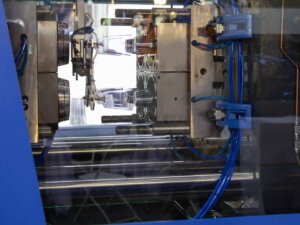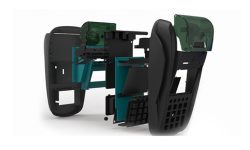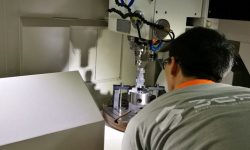Prototyping is an important part of the development and commercialization of medical devices. Most medical products have to meet strict safety requirements, so it is important to iterate a variety of prototypes for R&D and testing in order to make a safe and functional end-use part.
Different medical prototypes require different materials. The choice between certain metals and plastics can depend upon the end use of the part — is it an implant, an instrument, part of a machine, or something else? — and upon the stage of prototyping: early-stage prototypes may not need to be built from medically safe materials, but working prototypes usually do.
Although medical prototypes are many and varied, this article attempts to discuss the best material options at your disposal, from silicone to titanium. Note that the article lists common materials but is not exhaustive.
What is biocompatibility?
Medical device companies often make products that will come in direct contact with the human body. For the safety of patients, these products must be certified as biocompatible, which means that they will not harm the human body in any way when contact takes place.
Some metals and plastics are biocompatible, while others exhibit certain characteristics (toxicity, degradation, etc.) that make them unsafe for bodily interaction.
The US Food and Drug Administration (FDA) says this about biocompatibility:
Medical device companies assess the biocompatibility of a material by testing how the human body responds to the material they plan to use in their device. This biological evaluation of medical devices is performed to determine if there is a potential adverse biological response resulting from contact of the device’s component materials with the body and whether the associated risks are acceptable.
Different kinds of testing procedures exist for determining biocompatibility. These may involve administering samples of the material (orally, to the skin, implanted, etc.) to an animal test subject.
Materials for CNC machined medical prototypes
CNC machining is a useful manufacturing option for a variety of medical prototypes, both metal and plastic. It offers a much greater array material possibilities than other manufacturing processes. The following materials are all favored by medical device companies, but common materials like aluminum can also be used for early-stage prototypes.
PC, PEEK, PEI, PPSU, Acetal
Several biocompatible plastics are suitable for CNC machining. Materials like PEEK, PEI, and PPSU all have good temperature resistance and creep resistance and are therefore easy to sterilize, which is vital for prototypes of e.g. surgical instruments. Certain polycarbonates are ideal for clear medical parts like microfluidics devices, especially when treated with a polishing surface treatment.
Titanium
Titanium is a premium machinable metal that is suitable for many medical applications. Although it is not always feasible to prototype with titanium given the high cost of the material, titanium prototypes are lightweight and corrosion resistant. Titanium is often used for machined bodily implants and other devices.
Stainless steel
Less expensive than titanium, stainless steels like 316L are perfect for medical prototypes since they can be sterilized easily. This grade of stainless steel is regularly used for medical products like surgical instruments.
Materials for 3D printed medical prototypes
3D printing is becoming more widely used in the medical industry, although regulators are still catching up to the technology in certain areas. Medical-grade printing materials (below) are used for final-stage prototypes, but other common materials like ABS and PLA are used for early-stage medical prototypes where biocompatibility is not required.
Nylon
The additive manufacturing process of Selective Laser Sintering (SLS) is suitable for making nylon parts, including medical prototypes. It is one of a handful of 3D printable plastics (others include PC-ISO and PPSF) that can be sterilized, making it suitable for some healthcare applications.
Titanium
3D printed titanium implants are one of the most important and cutting-edge applications of AM in medicine. Selective Laser Melting (SLM) 3D printers can make implants in complex and lightweight shapes that encourage bone growth onto the implant. Prototyping these devices in titanium is expensive but fast, and provides a reliable indication of the final product. Besides implants, 3D printing is also ideal for the creation of titanium prostheses.
Materials for molded medical prototypes
Injection molding is widely used for the mass production of medical parts, and it may be beneficial to prototype medical parts using the same manufacturing technique. Although it is not cost-effective to prototype IM parts in small quantities, IM may be necessary for the prototyping of silicone parts.
PC, PEEK, PEI, PPSU
Many of the medical-grade plastics available as extrusions for CNC machining are also available in pellet form for injection molding. These materials are suitable for prototyping mass production parts rather than patient-specific devices and implants.
Liquid silicone rubber
Of the three processes discussed here, injection molding is the only viable production technique for making silicone rubber medical parts that are suitable for contact with human skin. The material is often used in overmolding, where part of the medical device is made from a rigid material like PC and another part is made from the supple silicone.
A cheaper alternative for silicone prototypes is vacuum casting, which we can use to create flexible parts similar in performance to injection molded parts.
Medical prototypes with 3ERP
3ERP has years of experience making medical device prototypes, from monitoring machinery to surgical instruments, and we can help you move your product towards completion. We can execute CNC machining, 3D printing, and injection molding projects, as well as projects that require multiple processes.
Request a free quote to begin your medical prototyping project with us.







